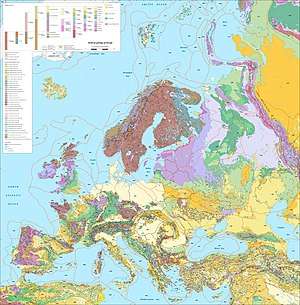Hellenic orogeny
The Hellenic orogeny was a mountain building event that affected what is now Greece, the Aegean Sea and western Turkey, beginning in the Jurassic as a series of small continents and remnant oceanic crust collided with Eurasia. The orogeny slowed or even stopped for a period of time and resumed during the early Cenozoic.
Sequence of the orogeny
In the late Jurassic, fragments of continental crust from the small content Cimmeria collided with Eurasia. Earlier, in the mid-Jurassic remnant oceanic crust formed ophiolites along the coast of Cimmeria. The oceanic crust of the Neotethys ocean subducted between the newly compounded Cimmerian-Eurasia continent, but obducted some more ophiolites onto the edge of the Cimmerian crust.
Tectonic activity resumed in the early Cenozoic when the small Apulia plate collided with the Cimmerian-Eurasian rocks causing intense imbrication and the deposition of the Pindos flysch. The final phase of the process came in the Miocene and Pliocene, during the Mesogean orogeny, when the combined Mesogean-African plate subducted beneath what is now Greece, the Aegean and parts of western Turkey. In the process, the Crete and southern Peloponessus core complexes were exhumed to the surface. [1]
Structural geology
The Hellenic orogen is made up of three orogenic belts. The Cimmerian orogenic belt in Greece comprises the Serbomacedonian, Circum Rhodope, Axios, Pelagonian and Rhodope zones, while the Bayburt, Sinop, Kirklareli and Sakarya zones are situated in Turkey. The Alpine orogenic belt includes Neo-Tethys oceanic sedimentary rocks, the Pindos-Subpelagonian ophiolites and the External Hellenides. [2] Apatite and zircon analysis in the southern Aegean suggests that metamorphism in the Cenozoic phase of the orogeny never exceeded 300 degrees Celsius. [3]
References
- Mountrakis, D. (2006). Tertiary and Quaternary tectonics of Greece. Geological Society of America, Special Paper 409. p. 125-126.
- Mountrakis 2006, p. 126.
- Ring, Uwe; Thomson, Stuart; Rosenbaum, Gideon (2006). Timing of the Amorgos detachment system and implications for detachment faulting in the southern Aegean Sea, Greece. Geological Society Special Publication No. 321.CS1 maint: multiple names: authors list (link)
